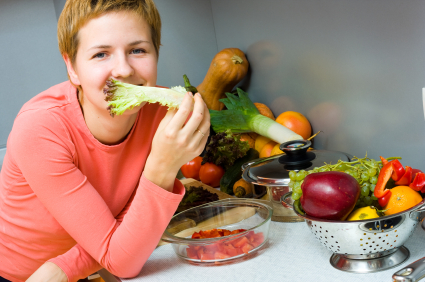Emphasize variety over quantity of fruits and vegetables, a recent study suggests.
Going to the grocery store and wading through the fruits and vegetables—fresh, frozen, packed and dried—can be confusing for anyone. So what do we do? We grab the same things every week. We buy what we are used to! Some fruits and veggies are better than no fruits or veggies, but research confirms that variety is, indeed, the spice of life.
As promised, during National Nutrition Month, Isagenix is dedicated to helping you make healthy choices in your diet. This week’s tip is to add color into your diet by increasing consumption and variety of fruits and vegetables. The old message was to eat at least five servings of fruits and vegetables each day, but now the message has changed: it’s not just about quantity, but the variety of fruit and vegetables that is important for reaping the full health benefit of these fibrous, low-calorie foods.
Fruit and vegetable variety was shown in a recently published study from American Journal of Clinical Nutrition to reduce levels of C-reactive protein (CRP) in the body. CRP increases when our bodies are stressed. The study found that those subjects who were consuming higher amounts of different colored fruits and vegetables actually reduced circulating CRP compared to those who had less variety in their diets.
The subjects of the study who had the highest fruit and vegetable consumption also benefited by having the highest intakes of dietary fiber (21 grams per day), and higher concentrations of serum antioxidant carotenoids, folate (a B vitamin) and ascorbic acid (vitamin C) compared to the folks who were averaging only two servings per day. (Note: fiber helps weight management by helping you feel full longer, support the gastrointestinal tract, and, especially soluble fiber, provides benefits for your heart). The phytochemicals, antioxidants, vitamins and minerals in fruits and vegetables are thought to protect the heart by reducing oxidative stress. This study shows, for the first time, that there may be synergy in diversity! The gist: Eat a variety of fruits and vegetables to improve your odds of getting that synergistic effect of various phytochemicals.
It’s no surprise that quantity of fruits and vegetables can reduce risk of various chronic aging conditions. Numerous epidemiological studies have documented a decreased risk of heart disease and stroke with increased fruit and vegetable intake. Other studies have found that participants who consumed more than five servings each day had a 26 percent reduction in risk of stroke and a 17 percent reduction of cardiovascular disease risk when compared to those consuming less than three servings per day.
The combined data from this newest trial and from past research support the recommendation to increase fruit and vegetable intake, but add variety to support health, particularly heart health.
While this is great news for the plant-adoring populace, many of us find increasing fruit and vegetable variety to be an intimidating task. However, it’s the time to expand your horizons! Isagenix provides a simple and easy way to help supplement your antioxidant intake from fruits and vegetables by enjoying the Isagenix Fruits and Greens! One serving of Isagenix Fruits, for example, delivers the equivalent in antioxidant strength of 20 servings of fruit. Even better, these rich antioxidant reservoirs are sourced from more than 30 different plants!
IsaFruits and Greens can be helpful as antioxidant-rich supplements, but they should never be used to replace all consumption of whole fruits and vegetables, which provide valuable food components like fiber, more antioxidant protection, and more phytochemicals. This month, take charge and learn to love your heart and your body with these four simple solutions to “Eat Your Colors”:
- Beets: bake them, steam then, sauté them, munch on them cold or add them to a salad (these purple veggies are rich in vitamin A, vitamin C, potassium, iron, folate and color!)
- Bell Peppers: sauté colored peppers in olive oil, salt and pepper and enjoy with whole wheat, semolina or buckwheat pasta! (Not only are they delicious but they have more vitamin C than an orange!)
- Purple cabbage: toss chopped cabbage and carrots into a salad (the visual appeal will be too hard to resist!)
- Skip the juice and go straight for the orange! (Most orange juice rapidly loses its Vitamin C content, and doesn’t contain all the fiber of the whole fruit, so it’s better to dodge the processing and go straight to the source.)
Reference: Bhupathiraju SN, Tucker KL. Greater variety in fruit and vegetable intake is associated with lower inflammation in Puerto Rican adults. Am J Clin Nutr 2011;93:37-46. doi: 10.3945
Related posts:
- March into Nutrition Month with Isagenix
- Dietary Guidelines 2010: Where Less is More
- Five Healthy Treats to Help You Control Cravings
The post Nutrition Month Tip: Fruits and Veggies, Think Variety appeared first on Isagenix Health.
Source: IsagenixHealth.net


You May Also Like
Post-Workout Super Shake
Winter Trail Mix
Apple Spice Granola
IsaDelight Bark With Caramel Brulée Drizzle
Caramel Brulée Cookie Dough Bites
Homestyle Chicken Noodle Soup
BĒA Super Sparkler
Peppermint Mocha Shake
IsaDelight Cashew Butter Cups
Plant-Based Banana Bread
Nature Oat Bake Granola
Nature Oat Bake Isa-Cream Sandwiches
Nature Oat Bake Skewers
BEA Mango Mimosa Slushie
Plant-Based Strawberry Ice Cream
Plant-Based Strawberry Crepes
Plant-Based Strawberry Muffins
Superpower Elixir
Plant-Based Maple Pecan Protein Balls
Immune-Boosting Oats
Celebration BĒA Sparkler
Bone Broth Chicken Gravy
Kale & Sausage Bone Broth Soup
IsaDelight Reindeer Bark
Holiday Charcuterie Board
Leftover Turkey and Vegetable Soup
Protein Chocolate Mug Cake
Vanilla Protein Coffee Creamer
Greens Lavender Iced Matcha Latte
Isagenix Greens Salad Dressing
Everyday Ginger-Infused Cleanse Tea
Choco-Lava Mug Cake